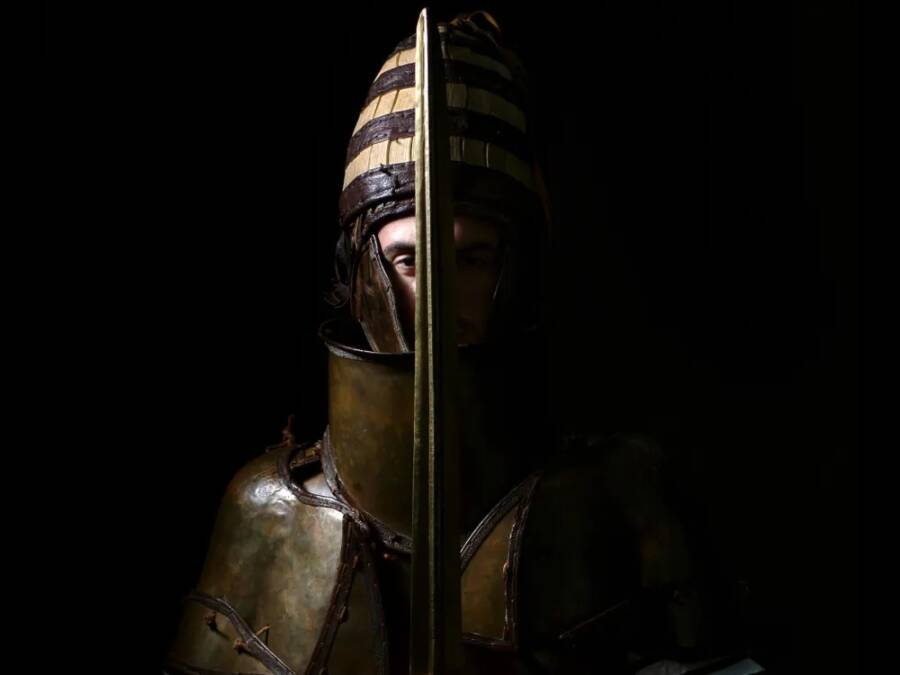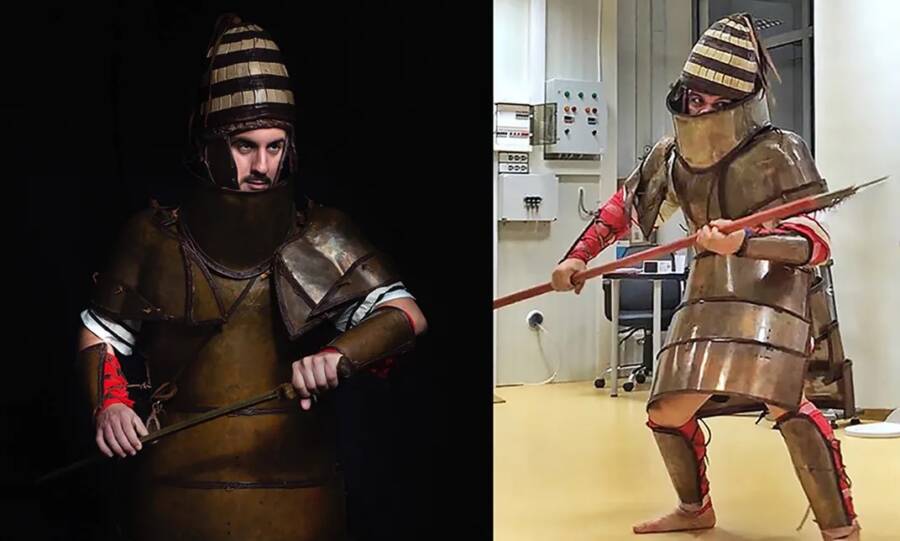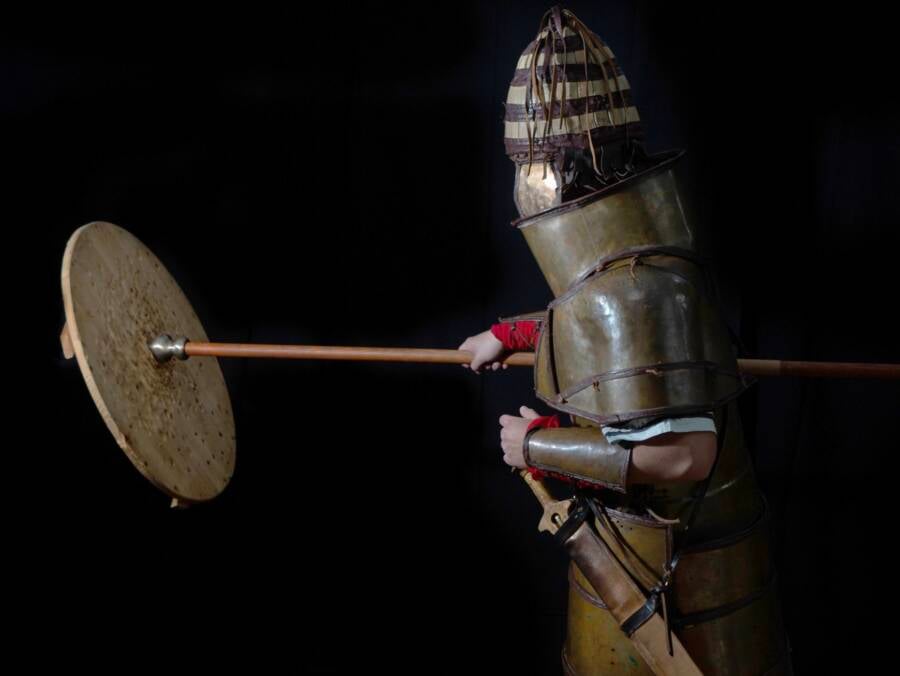The Dendra armor, used by ancient Mycenaeans, proved to be incredibly effective in combat, despite being cumbersome to wear for long periods.

Andreas Flouris and Marija Marković/PLOS ONEA replica suit of armor resembling one found near the ancient site of Mycenae, Greece.
Would ancient armor really have protected its wearers? That’s the question a team of researchers set out to answer recently by recreating a Greek suit of armor from the Bronze Age — and their answer was “yes.”
In a new study published in the journal PLOS ONE, a team of researchers ran a combat simulation using a replica of ancient Mycenaean armor to see how it would hold up in battle. Special armed forces personnel donned the armor and underwent an 11-hour simulated Bronze Age combat scenario.
The 3,500-year-old armor design held up shockingly well, offering further evidence that the Mycenaeans were a force to be reckoned with in the ancient world.
The Dendra Armor Was A “Secret Weapon” For Mycenaeans In Combat
In 1960, archaeologists working at the Mycenae archaeological site in Greece came across a complete 3,500-year-old suit of armor — one of the oldest ever discovered.
Known as the Dendra armor, the suit dates back to the 15th century B.C.E. and was made of nearly 60 pounds of copper alloy, its helmet fashioned from boars’ tusks. Surprisingly, the armor was in remarkable condition, with no clear signs of battle damage. This led some to theorize that it may have been used for ceremonial purposes rather than in combat.
Over the years, further research indicated that it was indeed battle worthy. Still, the armor was extremely bulky and heavy. Could it really have held up in a combat scenario?

Andreas Flouris and Marija Marković/PLOS ONEVolunteers wearing the replica Dendra armor were also fed a diet similar to that of an ancient Mycenaean warrior.
To test this out, researchers recruited 13 volunteers from the 32nd Marines Brigade of the Hellenic Army, outfitting them with replica suits of armor and conducting an 11-hour simulation of a late Bronze Age battle.
To determine what that battle would look like, they turned to the tales of the famous Greek storyteller, Homer.
Comparing Homer’s descriptions of the Trojan War in the Iliad with actual archaeological evidence, researchers found that Homer did “describe aspects of battle we know to be true of the Mycenaean world,” study co-author Ken Wardle of the University of Birmingham, told National Geographic.
Not only did the armor protect its wearer remarkably well, but researchers also believe the Dendra armor would have been a “secret weapon” for Mycenaeans.
What Combat Simulations Revealed About The Dendra Armor’s Efficacy
The 13 chosen volunteers generally fit the height, weight, and age parameters of late Bronze Age Greek warriors. To ensure near-total accuracy, the soldiers were also put on a nutrition plan of dry bread, beef, olives, goat cheese, onions, red wine, and water — a diet akin to that of an ancient Greek soldier.
Using both archaeological evidence and Homer’s descriptions of the Trojan War as a guide, researchers choreographed a Bronze Age battle simulation.
Each marine was outfitted in a Dendra armor replica weighing about 60 pounds and a boar-tusk helmet replica, and equipped with replica Bronze Age spears and swords. Over the course of 11 hours, the volunteers engaged in simulated combat, which included high-intensity-interval exercises like sprinting and striking blows, with brief breaks to rest or eat.

Andreas Flouris and Marija Marković/PLOS ONEA volunteer striking a target with Bronze Age weaponry.
In all, the volunteers ate roughly 4,400 calories, and each completed the simulation successfully. Only one volunteer showed signs of low blood sugar after the simulated battle. Notably, most of them also reported high levels of fatigue, foot pain, and a sore upper body — understandable, given the weight of the armor and the rigorous exercise.
What researchers discovered, however, is that the Dendra armor held up better than most other types of armor from the Bronze Age. The downside was that the Dendra armor rendered the soldiers less mobile, but it was a seemingly effective tradeoff, given that it kept its wearer alive longer.
Plates on the insides of the shoulder pieces, for instance, protected the armpits during close-range combat, but the armor was also effective at protecting its wearer in mid-range combat as well.
“We now understand, despite its cumbersome appearance at first sight, that it is not only flexible enough to permit almost every movement of a warrior on foot but also resilient enough to protect the wearer from most blows,” researchers wrote in the study.
The weight of the Dendra armor would have also influenced Mycenaeans’ combat strategies and weaponry.
“Leaders wore full, well-made, and functional armor and were typically elite warriors with extensive battle experience,” said study lead author Andreas Flouris of the University of Thessaly.
Not every soldier would have been outfitted with Dendra armor, either. In fact, “the majority of followers wore light or no armor, and their task was to protect their leader from close-range encounters,” Flouris said.
The Dendra armor provided clear tactical benefits that cannot be understated when discussing the history of warfare. As archaeologist Barry Molloy, who was not involved in the study but has studied the Dendra armor separately, told National Geographic, “Suits of armor like this would have transformed the battlefield.”
After reading about the modern tests of the Dendra armor, read about the Trojan Horse and the debate surrounding its existence. Then, read about the brazen bull, a torture method purportedly used in ancient Greece.





